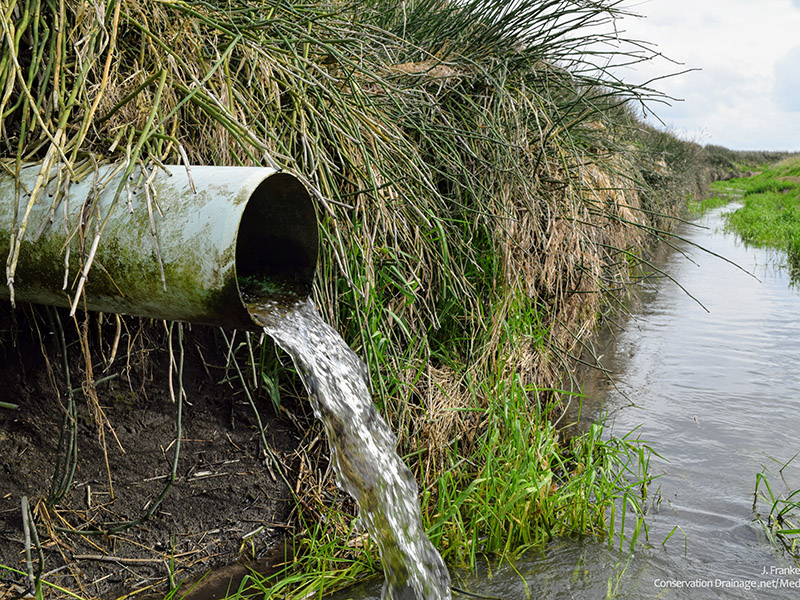
There is actually a lot here. I do like that cover crops in the off season counters nitrogen losses. It is at least posssible to prevent three quarters of the nitrogen fertilizer from been lost into the river system. That is a huge move in the right direction.
The long term trend will be toward increasingly sustainable methods so long term we are all going in the right direction.
Most of us will never live to actually see it, but the future will have spaced tree lines lifting deep nutrients while sponsoring polinators and a variety of perrenial plantings in support of grain and cover crops.
Tile drainage impacts yield and nitrogen
Draining waterlogged farm fields helps crops but can leach nitrogen into waterways. A three-decade-long experiment is helping farmers strike the right balance.
June 30, 2021 - As most kids know, a big pile of mud can be a load of fun.
But not for farmers. Muddy fields mean too much water. And too much water means crops might not grow well.
Farmers often install underground drains, called tile drains, in waterlogged soils to help move the excess water away quickly. The drier soils are beneficial to their crops.
But there is one potential downside: nitrogen. In the form of nitrate, nitrogen contaminates waterways. Plus, any nitrogen that leaves the field means wasted money for the farmer, who paid for fertilizer.
How can farmers balance draining their fields with holding onto nitrogen? For starters, they can turn to a decades-long experiment out of Purdue University. Results were published in the Journal of Environmental Quality.
For 31 years, researchers have studied how different farming practices and drainage strategies affect crop growth and nitrogen loss from fields.
“Drainage is a necessary practice on naturally wet soils. So it’s common on our productive soils in much of the Midwest,” says Eileen Kladivko, a member of the Soil Science Society of America. “But since the soil is leaky by nature, we want to know how we can reduce that nitrate concentration and load and still have good drainage.”
In their latest research, scientists share how fields performed in the last 16 years compared to the prior 15 years. In particular, they focused on the effect of different degrees of drainage.
Tile drains can be placed at different distances across a field. The closer they are, the faster they can drain water away from fields.
At the study fields in Indiana, drains were spaced either 5, 10 or 20 meters apart. As Kladivko’s group expected, the closer the pipes were, the more water flowed through them every year.
The concentration of nitrate in the water was the same regardless of drain spacing. But because closer drains led to more water flow, the total amount of nitrogen that left fields was higher when drains were closer together.
“The bottom line is that when the drains are closer together, they’re put there for the reason of draining more water faster,” says Kladivko. “So if we drain more water faster, we also drain more nitrate.”
The researchers also saw that most of the nitrate that left farm fields did so during the off season, when no big crops were around to use the nutrients.
Over 31 years, the researchers changed how they managed the fields. For example, they switched from growing only corn to crop rotations between corn and soybeans. They also reduced the amount of fertilizer they applied. And they started to plant cover crops, which grow during the off season. These changes followed the latest research and mirrored current practices farmers are using.
Because of these changes, the concentration of nitrate in the leaching water today is only a quarter of what it was three decades ago. This lower concentration means that less total nitrate leaches out than in the past.
The researchers noticed another trend. In wet years, more nitrate left farm fields because more water was there to carry it away. Recent years have been wetter, likely due to the changing climate.
“The takeaway is that as hard as we try, we cannot control every aspect of our farm fields,” says Kladivko.
Because a lot of nitrate left fields in the winter, some farmers could use a system called controlled drainage to make smart seasonal choices. With controlled drainage, farmers can allow fields to be wetter and drain slower in the winter when wet fields won’t hurt crops. Then in the spring, they can let drains work at full-speed and drain quickly.
And, because the fastest drainage doesn’t help crops grow that much better, farmers can choose wider drain spacing, which also saves money on installation.
“My message to farmers is don’t over drain,” says Kladivko. “Try to determine the widest possible spacing that allows for close to optimum yield.”
Eileen Kladivko is a professor of agronomy at Purdue University. This work was supported by the Purdue Agricultural Research Programs and the United States Department of Agriculture National Institute of Food and Agriculture.
Photo Caption: Water flows out of a tile drain and into a nearby ditch in Indiana. Although draining waterlogged fields improves crop growth, drainage water carries nitrate, a water contaminant. Credit: J. Frankenberger
High-resolution images for use with this story only available here, or contact Rachel Schutte, rschutte@sciencesocieties.org.
No comments:
Post a Comment